20.2: Exercise
- Page ID
- 105882
\( \newcommand{\vecs}[1]{\overset { \scriptstyle \rightharpoonup} {\mathbf{#1}} } \)
\( \newcommand{\vecd}[1]{\overset{-\!-\!\rightharpoonup}{\vphantom{a}\smash {#1}}} \)
\( \newcommand{\id}{\mathrm{id}}\) \( \newcommand{\Span}{\mathrm{span}}\)
( \newcommand{\kernel}{\mathrm{null}\,}\) \( \newcommand{\range}{\mathrm{range}\,}\)
\( \newcommand{\RealPart}{\mathrm{Re}}\) \( \newcommand{\ImaginaryPart}{\mathrm{Im}}\)
\( \newcommand{\Argument}{\mathrm{Arg}}\) \( \newcommand{\norm}[1]{\| #1 \|}\)
\( \newcommand{\inner}[2]{\langle #1, #2 \rangle}\)
\( \newcommand{\Span}{\mathrm{span}}\)
\( \newcommand{\id}{\mathrm{id}}\)
\( \newcommand{\Span}{\mathrm{span}}\)
\( \newcommand{\kernel}{\mathrm{null}\,}\)
\( \newcommand{\range}{\mathrm{range}\,}\)
\( \newcommand{\RealPart}{\mathrm{Re}}\)
\( \newcommand{\ImaginaryPart}{\mathrm{Im}}\)
\( \newcommand{\Argument}{\mathrm{Arg}}\)
\( \newcommand{\norm}[1]{\| #1 \|}\)
\( \newcommand{\inner}[2]{\langle #1, #2 \rangle}\)
\( \newcommand{\Span}{\mathrm{span}}\) \( \newcommand{\AA}{\unicode[.8,0]{x212B}}\)
\( \newcommand{\vectorA}[1]{\vec{#1}} % arrow\)
\( \newcommand{\vectorAt}[1]{\vec{\text{#1}}} % arrow\)
\( \newcommand{\vectorB}[1]{\overset { \scriptstyle \rightharpoonup} {\mathbf{#1}} } \)
\( \newcommand{\vectorC}[1]{\textbf{#1}} \)
\( \newcommand{\vectorD}[1]{\overrightarrow{#1}} \)
\( \newcommand{\vectorDt}[1]{\overrightarrow{\text{#1}}} \)
\( \newcommand{\vectE}[1]{\overset{-\!-\!\rightharpoonup}{\vphantom{a}\smash{\mathbf {#1}}}} \)
\( \newcommand{\vecs}[1]{\overset { \scriptstyle \rightharpoonup} {\mathbf{#1}} } \)
\( \newcommand{\vecd}[1]{\overset{-\!-\!\rightharpoonup}{\vphantom{a}\smash {#1}}} \)
Scientific Method
Part 1: The Strange Case of BeriBeri: 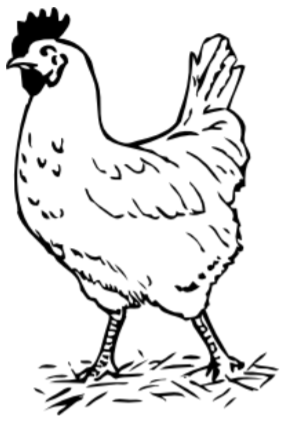
In 1887 a strange nerve disease attacked the people in the Dutch East Indies. The disease was beriberi. Symptoms of the disease included weakness and loss of appetite, victims often died of heart failure. Scientists thought the disease might be caused by bacteria. They injected chickens with bacteria from the blood of patients with beriberi. The injected chickens became sick. However, so did a group of chickens that were not injected with bacteria. One of the scientists, Dr. Eijkman, noticed something. Before the experiment, all the chickens had eaten whole-grain rice, but during the experiment, the chickens were fed polished rice. Dr. Eijkman researched this interesting case and found that polished rice lacked thiamine, a vitamin necessary for good health.
1. State the problem.
2. What was the hypothesis?
3. How was the hypothesis tested?
4. Do the results indicate that the hypothesis should be rejected?
5. What should be the new hypothesis and how would you test it?
Part 2: How Penicillin Was Discovered:
In 1928, Sir Alexander Fleming was studying Staphylococcus bacteria growing in culture dishes. He noticed that a mold called Penicillium was also growing in some of the dishes. A clear area existed around the mold because all the bacteria that had grown in this area had died. In the culture dishes without the mold, no clear areas were present. Fleming hypothesized that the mold must be producing a chemical that killed the bacteria. He decided to isolate this substance and test it to see if it would kill bacteria. Fleming transferred the mold to a nutrient broth solution. This solution contained all the materials the mold needed to grow. After the mold grew, he removed it from the nutrient broth. Fleming then added the nutrient broth in which the mold had grown to a culture of bacteria. He observed that the bacteria died which was later used to develop antibiotics used to treat a variety of diseases.
1. Identify the problem.
2. What was Fleming's hypothesis?
3. How was the hypothesis tested?
4. Do the results indicate that the hypothesis should be rejected?
5. This experiment led to the development of what major medical advancement…?
Part 3: Identify the Controls and Variables 
Smithers thinks that a special juice will increase the productivity of workers. He creates two groups of 50 workers each and assigns each group the same task (in this case, they're supposed to staple a set of papers). Group A is given the special juice to drink while they work. Group B is not given the special juice. After an hour, Smithers counts how many stacks of papers each group has made. Group A made 1,587 stacks; Group B made 2,113 stacks.
Identify the:
- Control Group:
- Independent Variable:
- Dependent Variable:
What should Smithers' conclusion be?
How could this experiment be improved?
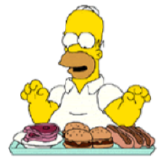
Homer notices that his shower is covered in a strange green slime. His friend Barney tells him that coconut juice will get rid of the green slime. Homer decides to check this out by spraying half of the shower with coconut juice. He sprays the other half of the shower with water. After 3 days of "treatment", there is no change in the appearance of the green slime on either side of the shower.
What was the initial observation?
Identify the:
- Control Group:
- Independent Variable:
- Dependent Variable:
What should Homer's conclusion be?
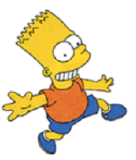
Bart believes that mice exposed to radio waves will become extra strong (maybe he's been reading too much Radioactive Man). He decides to perform this experiment by placing 10 mice near a radio for 5 hours. He compared these 10 mice to another 10 mice that had not been exposed. His test consisted of a heavy block of wood that blocked the mouse food. He found that 8 out of 10 of the exposed mice were able to push the block away, while 7 out of 10 of the other mice were able to do the same.
Identify the:
- Control Group:
- Independent Variable:
- Dependent Variable:
What should Bart's conclusion be?
How could Bart's experiment be improved?
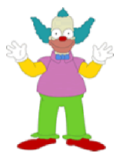
Krusty was told that a certain itching powder was the newest best thing on the market: it even claims to cause 50% longer lasting itches. Interested in this product, he buys the itching powder and compares it to his usual product. One test subject (A) is sprinkled with the original itching powder, and another test subject (B) was sprinkled with the Experimental itching powder. Subject A reported having itches for 30 minutes. Subject B reported having itches for 45 minutes
Identify the:
- Control Group:
- Independent Variable:
- Dependent Variable:
Explain whether the data supports the advertisement's claims about its product.
How could this experiment be improved?
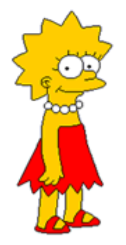 Lisa is working on a science project. Her task is to answer the question: "Does Rogooti (which is a commercial hair product) affect the speed of hair growth". Her family is willing to volunteer for the experiment.
Lisa is working on a science project. Her task is to answer the question: "Does Rogooti (which is a commercial hair product) affect the speed of hair growth". Her family is willing to volunteer for the experiment.
Design Lisa's experiment.
Using the Scientific Method to Investigate Termite Behavior
Procedure:
- Obtain a termite from the class supply. You will use a paintbrush to gently put your termite in a cup and bring it to your lab bench.
- Obtain a piece of clean white paper and place your termite on the paper. Observe it for a bit, noting any interesting behaviors.
- You will do two experiments with your termite, one introductory experiment and one of your own design.
Experiment 1:
- Obtain a clean piece of white paper, a pencil, a ballpoint pen, and a sharpie.
- Draw three circles on your piece of paper, one circle with each type of writing implement.
- Write a hypothesis and prediction for this experiment: How do you think the termite will react to each circle? Why?
- Place your termite into each circle and record the results. What happens when the termite encounters each circle? Does it follow each of the trails?
Experiment 2:
- You have many options of writing implements: pens, pencils, markers, etc. with which to make trails.
- Write a hypothesis and a prediction. Questions to consider as you write your hypothesis:
- What types of trails do you think your termite will follow or avoid, and why?
- Does shape matter?
- Can you trick your termite?
- Design your experiment: what is your independent variable? What is your dependent variable? What are your control and experimental groups?
- Check in with your instructor before you start your experiment.
- Conduct your experiment.
- Write a brief conclusion. What did you find? Did your results support your hypothesis?
Taxonomy
Part 1: A Simple Dichotomous Key
A dichotomous key is a tool used to determine the identity of species that have been previously described. You can think of it as a series of questions in which each question only has two possible answers.
In the table below, you have been given a list of creatures and their descriptions. The different characteristics, behaviors, and habitats of the creatures can be used in the dichotomous key to differentiate among them.
| Creature | Description |
|---|---|
| Jackelope | Mean-spirited horned jack rabbit |
| Chupacabra | Reptilian creature covered in scales with spines along the dorsal ridge; likes to eat goats |
| Altamaha-ha | Water monster with an alligator-like head and long neck; lives in the marshes of Coastal Georgia |
| Sasquatch | Stinky giant humanoid covered in brown fur; found in the forests of North America |
| Yeti | Giant mountain humanoid covered in white fur; prefers the snow |
| Kraken | Giant octopus-like creature; takes down ships in the open ocean |
| Nessie | Water monster with a snake-like head and long neck; lives in Loch Ness, in the Scottish highlands |
Below, you will find the dichotomous key used to identify a folkloric creature you may come across. On the left is the list of questions and on the right, the same list is represented as a flowchart. Both are useful representations of the same dichotomous key.
1. Does the creature live on land? 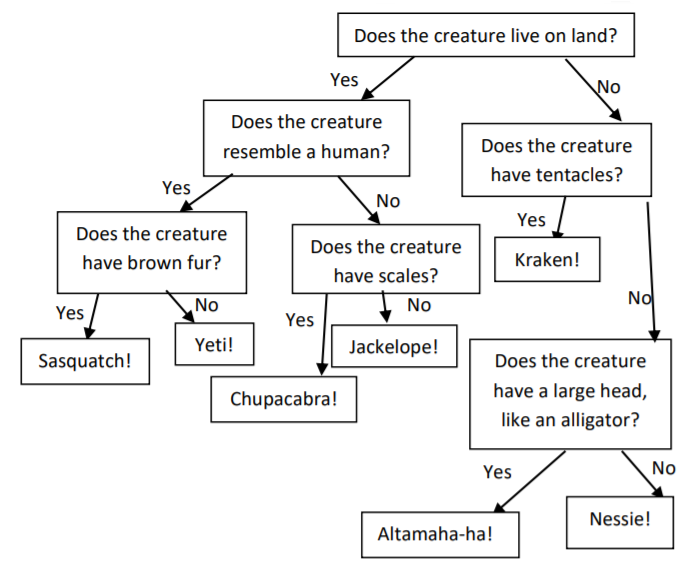
- a. Yes: go to question 2
- b. No: go to question 5
2. Does the creature resemble a human?
- a. Yes: go to question 3
- b. No: go to question 4
3. Does the creature have brown fur?
- a. Yes: Sasquatch!
- b. No: Yeti!
4. Does the creature have scales?
- a. Yes: Chupacabra!
- b. No: Jackelope!
5. Does the creature have tentacles?
- a. Yes: Kraken!
- b. No: go to question 6
6. Does the creature have a large head, resembling an alligator?
- a. Yes: Altamaha-ha!
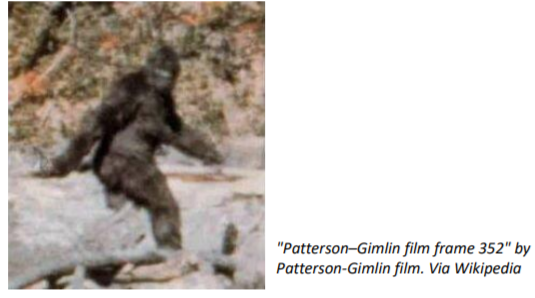
- b. No: Nessie!
Using the dichotomous key, identify the creature on the right.
Part 2: Building a Dichotomous Key
In the table below, there are several different emojis. Your job is to build a dichotomous key that would help distinguish among them. There is space in the table to write out a description of each emoji, if necessary, as well as a name for each. Record your question series in the space below.
| Emoji | Description | Name |
|---|---|---|
 |
||
 |
||
 |
||
 |
||
 |
||
 |
Dichotomous Key Questions:

Part 3: Using a Dichotomous Key to Identify Trees
In this section, a dichotomous key will be used to identify tree species based on samples provided by your instructor. Refer to the guide provided should any terms about the characteristics used to distinguish among trees be unfamiliar.
| Plant Number | Scientific/Common Name |
|---|---|
| Plant 1 | |
| Plant 2 | |
| Plant 3 | |
| Plant 4 | |
| Plant 5 | |
| Plant 6 | |
| Plant 7 |

